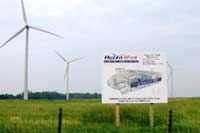Renewing energy practices
 Ontario, Canada's most populous province and home to one third of its population, is poised to take a lead in renewable energy utilisation in North America. Though several American states have set renewable energy targets, they haven't introduced effective mechanisms for the growth of renewables. But Ontario's ruling Liberal Party recently endorsed a policy mechanism widely used in Europe for the purpose.
Ontario, Canada's most populous province and home to one third of its population, is poised to take a lead in renewable energy utilisation in North America. Though several American states have set renewable energy targets, they haven't introduced effective mechanisms for the growth of renewables. But Ontario's ruling Liberal Party recently endorsed a policy mechanism widely used in Europe for the purpose.
It adopted a resolution supporting Advanced Renewable Tariffs, the mechanism at the heart of Germany's successful Renewable Energy Sources Act. It permits farmers, cooperatives, and businesses to connect their wind turbines and solar panels to the grid. The law also specifies how much they will be paid and for how long. Thus, unlike other mechanisms used to develop renewable energy, this law elicits the active participation of citizens and businesses. "This is a milestone,' says Paul Gipe, an adviser to the Ontario Sustainable Energy Association, a non-governmental organisation. "There's a growing realisation that a new approach is needed towards renewable energy. Ontario may well become a model for the rest of North America.
Related Content
- Order of the Supreme Court regarding protection of Great Indian Bustard (GIB) and Lesser Florican, 21/03/2024
- Renewable energy and sustainability report
- Geothermal energy: unveiling the socioeconomic benefits
- Chhattisgarh State Electricity Regulatory Commission (Terms and conditions for determination of generation tariff and related matters for electricity generated by plants based on renewable energy sources) (First Amendment) Regulations, 2023
- Agricultural residue-based bioenergy: regional potential and scale-up strategies
- Renewable energy for remote communities: a guidebook for off-grid projects
